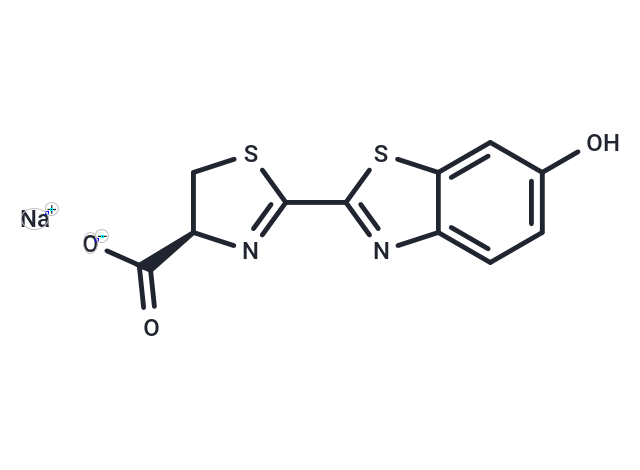Shopping Cart
Remove All Your shopping cart is currently empty
Your shopping cart is currently empty
D-Luciferin Sodium is a heterocyclic light-emitting compound and natural ligand for luciferase used to detect cell activity. The salt form of luciferin dissolves in water or other typical buffers.

| Pack Size | Price | USA Warehouse | Global Warehouse | Quantity |
|---|---|---|---|---|
| 5 mg | $30 | In Stock | In Stock | |
| 10 mg | $43 | In Stock | In Stock | |
| 25 mg | $54 | In Stock | In Stock | |
| 50 mg | $59 | In Stock | In Stock | |
| 100 mg | $89 | In Stock | In Stock | |
| 500 mg | $219 | In Stock | In Stock | |
| 1 mL x 10 mM (in DMSO) | $39 | In Stock | In Stock |
| Description | D-Luciferin Sodium is a heterocyclic light-emitting compound and natural ligand for luciferase used to detect cell activity. The salt form of luciferin dissolves in water or other typical buffers. |
| Cell Research | I. Solution preparation 1. Preparation of stock solution: Dissolve D-Luciferin sodium in saline or PBS to prepare a stock solution of appropriate concentration, with a common concentration range of 1-10mM. 2. Preparation of working solution: Dilute the D-Luciferin sodium stock solution to the required working solution concentration (generally 100 μM to 1 mM) II. In vivo and in vitro imaging Experimental steps: 1. Add to cells or animals: According to experimental requirements, inject or add D-Luciferin sodium into cell culture medium, animal body or target cells. For in vivo imaging of animals, it is usually administered by intraperitoneal injection or intravenous injection. 3. Reaction initiation: After D-Luciferin sodium reacts with luciferase, it produces detectable bioluminescence at a specific wavelength (usually around 550 nm). Use a bioluminescence imaging system (BLI) or a fluorescence detector for real-time monitoring. 4. Image acquisition: Use an imaging system to obtain luminescence signals and analyze image data to obtain bioluminescence information about cells, tissues or organs. II. Luciferase activity detection: Experimental steps: 1. Prepare D-Luciferin sodium solution (concentration is generally 100 μM to 1 mM). b. Take an appropriate amount of cell or animal sample labeled with luciferase. c. Add D-Luciferin sodium solution to the sample to start the luminescence reaction. d. Use a bioluminescence detector to record the luminescence signal in real time and perform data analysis. 3. Cell experiment: Experimental steps: a. Cultivate cells with luciferase gene. b. Add an appropriate amount of D-Luciferin sodium solution and incubate until the reaction is complete. c. Detect the luminescence signal by a fluorescence spectrophotometer or bioluminescence imaging device. |
| Molecular Weight | 302.29 |
| Formula | C11H7N2NaO3S2 |
| Cas No. | 103404-75-7 |
| Smiles | [Na+].Oc1ccc2nc(sc2c1)C1=N[C@H](CS1)C([O-])=O |
| Relative Density. | no data available |
| Color | Yellow |
| Appearance | Solid |
| Storage | keep away from direct sunlight,store at low temperature | Powder: -20°C for 3 years | In solvent: -80°C for 1 year | Shipping with blue ice/Shipping at ambient temperature. | ||||||||||||||||||||||||||||||||||||||||
| Solubility Information | DMSO: 16.67 mg/mL (55.15 mM), Sonication is recommended. H2O: 100 mg/mL (330.81 mM), Sonication is recommended. | ||||||||||||||||||||||||||||||||||||||||
| In Vivo Formulation | 10% DMSO+40% PEG300+5% Tween-80+45% Saline: 1.5 mg/mL (4.96 mM), Sonication is recommeded. Please add the solvents sequentially, clarifying the solution as much as possible before adding the next one. Dissolve by heating and/or sonication if necessary. Working solution is recommended to be prepared and used immediately. The formulation provided above is for reference purposes only. In vivo formulations may vary and should be modified based on specific experimental conditions. | ||||||||||||||||||||||||||||||||||||||||
Solution Preparation Table | |||||||||||||||||||||||||||||||||||||||||
DMSO/H2O
H2O
| |||||||||||||||||||||||||||||||||||||||||
| Size | Quantity | Unit Price | Amount | Operation |
|---|

Copyright © 2015-2026 TargetMol Chemicals Inc. All Rights Reserved.